

Table of contents
- growth and flowering
- Location
- Floor
- Plant
- tub culture
- Fertilize
- Pour
- Cut
- radical cut
- Cutting when wilted
- diseases and pests
- Hibernation outdoors
- Overwinter potted plants
'Nelly Moser' is one of the stars in the extensive clematis family. Even impatient gardeners are delighted by its rapid growth and rich blooms year after year. Numerous pink petals with a decorative violet-red central stripe contrast particularly well with the green background of the leaves. With a few suitable care measures, it climbs high and conquers every trellis. It also lends a colorful shine to dreary walls.
growth and flowering
The Clematis 'Nelly Moser' quickly scales heights of up to 3.50 m with the support of a trellis. House walls and rose trellis also give it the support it needs, because its tendrils are thin and do not provide enough support on their own. Fresh green leaves sprout every spring and form an opaque work. From May, the beautiful flowers are added in almost lavish abundance. Their diameter is between 12 and 15 cm. From August, good care will be rewarded with an encore: a second round of flowers is heralded. In autumn, the leaves and flowers gradually disappear and the bare, inconspicuous tendrils go into winter.
Location
For lush flower growth it can be sunny, the more the better. Only the blazing midday sun should be avoided. 'Nelly Moser' is also content with a partially shaded spot. In the shade, growth would be rather stunted and the formation of flowers would suffer. While the above-ground parts of this climber enjoy the sun, sun rays are completely undesirable in the root area. When planting, this wish must be fulfilled from the very beginning. There are several solutions for this, some of which can also be combined with one another:
- Ground covers catch the sun's rays
- 10 cm of mulch keeps the roots cool
- Plant the root ball about 10 cm deeper
- Place plant neighbors to provide shade
Floor
There are two reasons for a loose soil. First, the delicate roots of clematis do not encounter as much resistance as they grow. In a deeply loosened soil, they can quickly penetrate the deep layers of the earth to find water there even on warm days. A clematis that can take care of its own water balance saves the gardener a lot of work. Second, loose soil allows excess water to seep away more easily. After all, clematis does not like wet roots. Ideally, a few pebbles are added to the soil under the bale to prevent waterlogging. In addition, the soil may be nutrient-rich so that the flower appears in the desired splendor. Incorporated compost ensures that the soil is ideally nourished.
Plant

There are two ways to free the clematis from its narrow housing after purchase: a large bucket or the garden bed. The 'Nelly Moser' is extremely hardy and can be comfortably set up outdoors all the time. If you have found a suitable location in the fresh air for the clematis, you can plant them out according to the following instructions:
- First provide the bale with plenty of water. He should stand in a bucket of water for at least 20 minutes.
- Dig a planting hole and loosen the soil deeply.
- Place a drainage layer of pebbles in the planting hole.
- Mix the excavated soil with compost to enrich it with nutrients.
- Now you can free the clematis from its old pot without pulling on the tendrils. Hold the plant upside down and it can slide out.
- Plant the clematis about 10 cm deep so that the roots are better protected from the sun.
- Fill in the gaps with the soil enriched with compost.
- Form a watering wall around the plant and water it.
- Attach a trellis right away, as the clematis grows quickly.
Tip:
Planting out the clematis is a good opportunity to preventively protect it from being eaten by mice. Plant the root ball with a trellis to keep voles at a safe distance.
tub culture
If you don't have a garden space available, you can use a large planter. As a container plant, however, the clematis has some requirements in terms of pot and care.
- large pot with min. 25 liters volume is a must
- large bottom holes ensure water drainage
- a drainage layer helps against unwanted waterlogging
- high-quality and nutrient-rich soil
- Roots must be protected from the sun's rays
- stable climbing aid is required
- beautiful, branched form is achieved by pruning
- As a container plant, it needs winter quarters without frost
- as a second choice: a protected stand and plenty of fleece
Tip:
The initially nutrient-rich soil is leached out over time and should be replaced with new ones. After about four years, it's time for a fresh environment.
Fertilize
The clematis is a plant that needs to be well supplied with nutrients during the growing season. Only then does it sprout well and form many flowers. Horn shavings can provide a sufficient supply if they are applied early in the spring. The microorganisms in the soil gradually release the nutrients so that they can be easily absorbed and utilized by the clematis. Rose fertilizer has also proven itself with the clematis and can be used during the flowering period. By August at the latest, the fertilizer season is over, as the winter rest period for the clematis will soon be approaching.
Pour
A clematis becomes more and more self-sufficient over the years when it comes to its water balance. Their roots reach deep into the earth, where there is still some residual moisture even on dry days. Nevertheless, it needs to be watered from time to time.
- additional watering is required on particularly hot days
- young clematis have not yet developed sufficient roots
- water more often in the first few years
- the moisture evaporates faster from the pots
- Potted plants therefore suffer from drought more quickly
- always water well dosed to avoid waterlogging
- prefer to supply smaller amounts of water more often
Cut
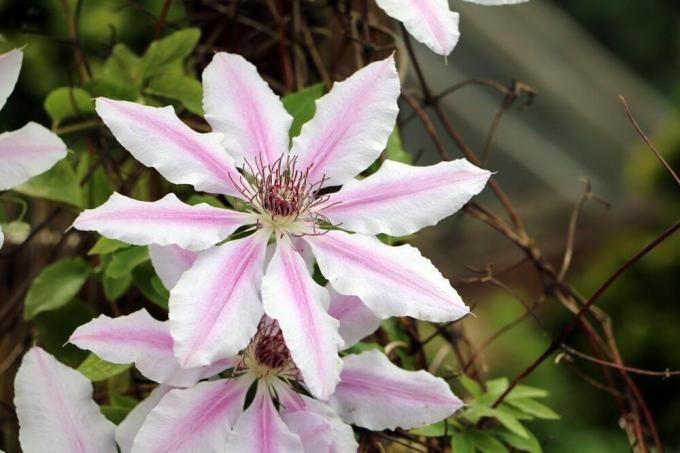
Depending on the growth and flowering behavior, the different clematis require different cuts. Experts have therefore divided the clematis into three groups. The pruning recommendations should be followed so that the clematis develops and blooms well.
- the twice flowering 'Nelly Moser' belongs to pruning group 2
- slightly cut back to about half
- Autumn is the right time for this pruning measure
- short shoots sprout on the remaining wood in spring
- the flowers are formed on it
radical cut
In order for the climbing plant not to bare over time, a strong pruning is occasionally necessary.
- every four to five years
- cut back to 20 to 50 cm
- only in the following year does it bloom more sparsely
The clematis quickly recovered from this radical pruning measure and is already in full bloom in the flowering season after next.
Cutting when wilted
A clematis that finds all the desired conditions is quite disease resistant. If the dreaded clematis wilt attacks them anyway, the pruning shears have to be picked up quickly.
- first thoroughly disinfect the cutting tool
- cut off all affected parts
- Also pick up leaves from the ground
- Dispose of cut off in the residual waste
- Then disinfect the cutting tool again
A notice:
However, if the root base is affected by the fungus, the clematis is beyond help.
diseases and pests
A hot summer can bring powdery mildew. In order to keep the damage to the clematis to a minimum, the affected plant should be treated promptly with a suitable agent. An animal danger threatens the roots of clematis from the voles. They love the roots of this clematis so much that they don't leave much of it. But the clematis cannot survive without its roots. If your garden is a playground for these pests, the clematis needs reliable protection. If the roots are already protected with a mesh basket when planting out, the mice don't stand a chance.
Tip:
Powdery mildew can still be fought naturally in the initial phase, as long as the spread has not progressed too far. A mixture of one part whole milk and eight parts water works well for misting the plant.
Hibernation outdoors
In autumn, 'Nelly Moser' sheds her tendrils and begins her well-deserved rest period. It is extremely hardy and requires little help.
- a covering of fir branches keeps out the icy wind
- Mulch layer provides some warmth
- Freshly planted clematis are not yet sufficiently hardy
- Be sure to protect young clematis in the first few years
- fully grown clematis are more resilient to cold
Overwinter potted plants
Container plants should not spend the winter outside, even if the clematis growing in them is considered hardy. In the bucket, the roots are not well protected against frost.
- a bright and cool room is ideal for winter
- Bring clematis in before the first frosts
- from mid-May the bucket can go out again
- alternatively, the clematis can overwinter outside
- the location should be sheltered from the wind
- Wrap the plant and tub with plenty of fleece
- Fleece can be removed again from May
 garden editorial
garden editorial I write about everything that interests me in my garden.
Learn more about clematis
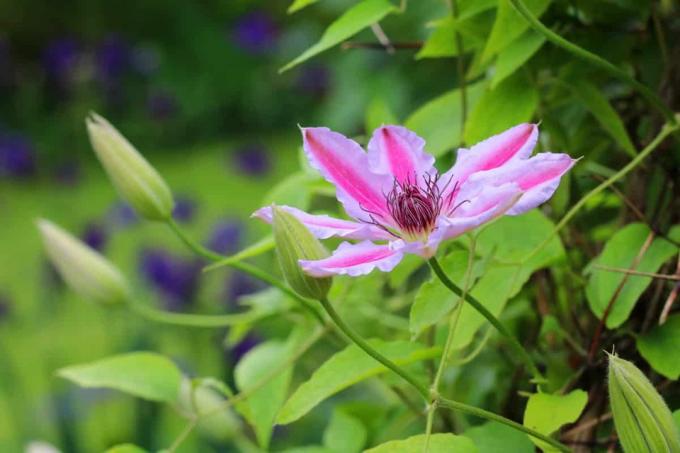
Lice, beetles & co: common clematis pests
Above and below ground there are many pests that can pose a threat to clematis. Without suitable countermeasures, some pests can damage a magnificent perennial so much within a few days that it dies.
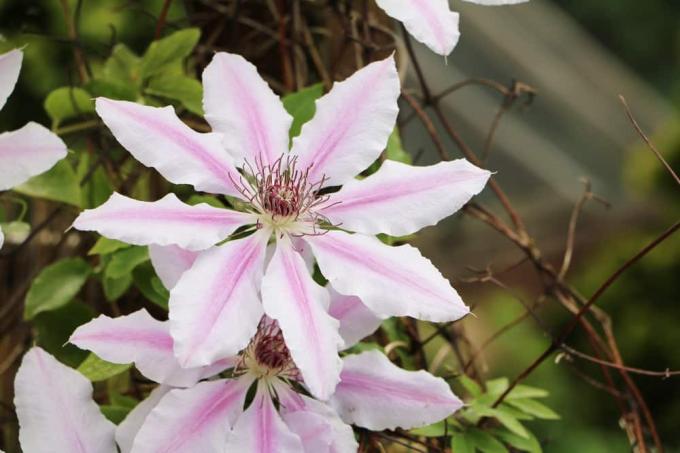
Pruning clematis: Instructions for late and early flowering varieties
Clematis is known and loved for its diverse flower shapes and colors. The plants, also known as clematis, are extremely decorative plants that can be used in many places in the garden to green trellises, pergolas, arbors and walls.

Clematis gets brown leaves - combat clematis wilt
Clematis wilt is a menacing disease that occasionally afflicts clematis. Especially the popular, large-flowered hybrids are being swept away at high speed. Left to its own devices, the clematis is helplessly at the mercy of the fungal pathogen. However, with the help of her owner, she is able to survive.
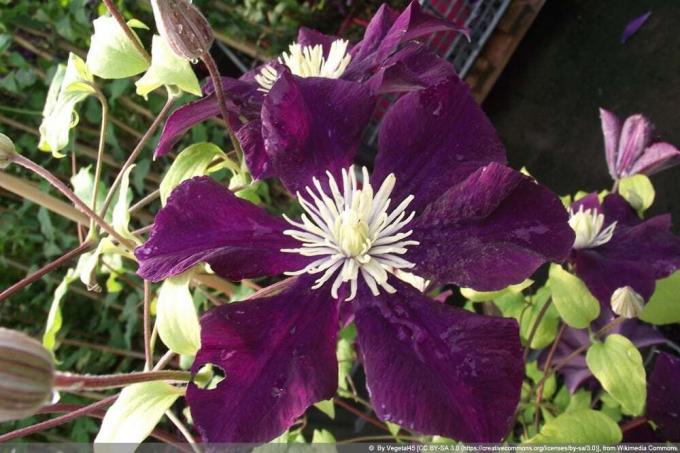
Clematis 'Warszawska Nike' Warsaw Night - care and pruning
The Clematis 'Warszawska Nike' Warsaw Night scores with its flowers. With the easy-care climbing plant you definitely get an eye-catcher in the garden. Only the cut is a bit difficult and requires courageous access. More about this is here.
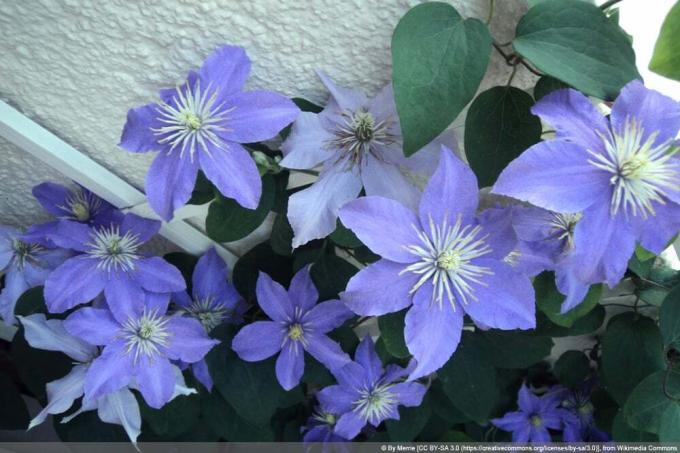
Clematis 'Justa' clematis - profile, care and cutting
Clematis 'Justa' clematis is a dwarf variety that has strong growth. In the summertime, the plant adorns itself with beautiful purple flowers that can also shine light blue. The clematis grows climbing and can reach a considerable height.

Clematis 'Piilu' clematis - profile, care and cutting
Clematis 'Piilu' is a particularly attractive and floriferous representative of the clematis. Its large, plate-shaped flowers captivate with an extraordinary color brilliance in dreamlike pink to violet and a second bloom until September.
